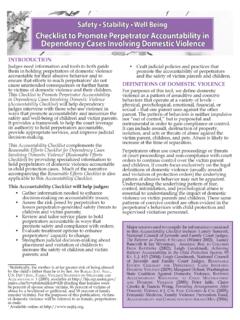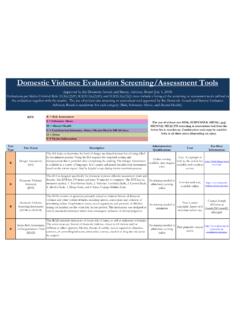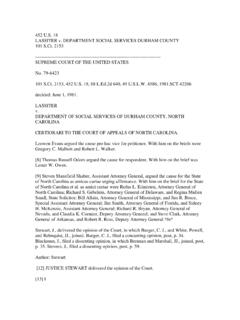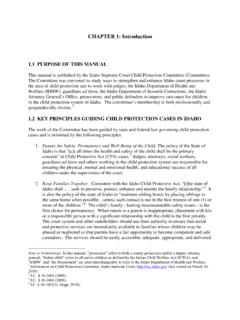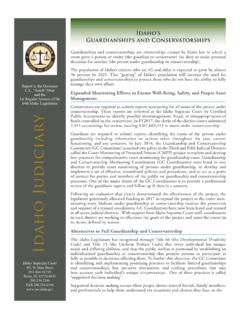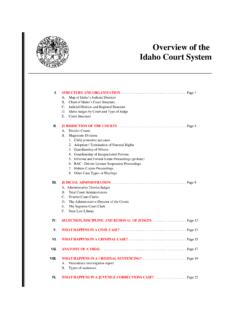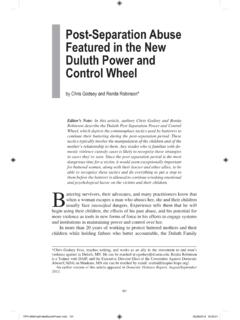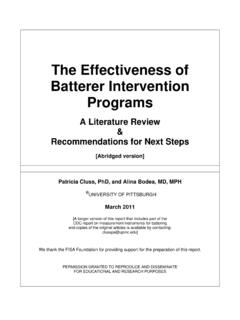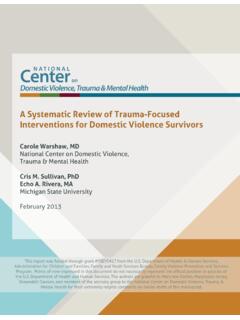Transcription of Certified Batterer Intervention Programs - Supreme Court
1 1 Certified Batterer Intervention Programs : History, Philosophies, Techniques, Collaborations, Innovations and Challenges David Adams, (Adapted and updated from article that first appeared in Clinics in Family Practice, Vol. 5(1), May 2003) While treatment Programs for batterers have proliferated in the United States over the past 20 years, little is known about these Programs by other human service providers, and much less by the general public. This article reviews the historical development of such Programs , overviews their goals and methodology, and concludes with a discussion of emerging issues. At this writing, at least 1,500 Batterer Intervention Programs exist in the United States and the number continues to grow. Part of the general public s unfamiliarity about Batterer Intervention Programs stems from the fact that domestic violence is itself only beginning to be widely viewed both as a social problem and as criminal behavior.
2 While defining domestic violence as criminal behavior has served to elevate battering as a serious issue, it has also tended to reinforce popular stereotypes of batterers as a social subset of the population; those who get arrested. This obscures the reality that batterers come from all walks of life and that Batterer Intervention Programs are not intended only for the worst offenders of domestic violence, or those who successfully prosecuted. History Most Batterer Intervention Programs have been established since the mid 1990 s. While a few Programs provide groups for women who abuse their male partners, and even fewer serve lesbians and gay men, the vast majority of Programs are geared for heterosexual men who abuse their female partners. Men attending these Programs are overwhelmingly Court -referred, though the exact proportion isn t known and varies from program to program.
3 The original Programs , including Emerge in Boston, RAVEN in St. Louis, AMEND in Denver, Manalive in Marin County California, the domestic Assault Program in Tacoma Washington, and Men Stopping Violence in Atlanta were established in the late 70 s, before significant numbers of batterers were arrested and mandated into such Programs . The nation s first program, Emerge, was established in Boston in 1977 by a group of ten men at the behest of women who were working in Boston-area battered women s Programs . [1] Staff at RESPOND, Transition House and Casa Myrna Vazquez, charged with helping battered women, had been also been fielding calls on their hotline from abusive men who were often desperate for help. Some were seeking counseling in hopes of reconciling with their partners while others were hoping to avert a separation. Other early Programs like RAVEN, AMEND and the Oakland Men s Project were similarly founded by men who had backgrounds in social services or experience in social causes such as the anti-war movement of the Vietnam era, and the civil rights movement.
4 Most had also been allies of women involved in the woman s rights movement. [2] 2 By the mid to late 1980 s, a second generation of Batterer Intervention Programs began to Emerge. By then, most states began to enact pro-arrest and prosecution policies regarding perpetrators of domestic violence. In some cases, these new policies were prompted by new laws that expanded police powers of arrest for domestic violence and even created liability for police who failed to protect victims. [3] In other cases, states merely began to more consistently enforce existing laws. Some states and jurisdictions developed new guidelines relating to police and Court responses to domestic violence. While these protocols vary from state to state, they have in common the dual goals of protecting victims and increasing accountability for perpetrators. Police in many states are now required to advise victims of their rights, offer them assistance and referrals, and arrest the alleged perpetrator when there was probable cause to believe that domestic violence had occurred.
5 Many states and counties have also adopted victimless prosecution policies in which prosecution of the offender does not depend upon the testimony of the victim, thereby reducing the likelihood of retaliation to victims who testify against their abusers. These new protocols have been accompanied by ongoing trainings of police and prosecutors that are intended to increase sensitivity to victims, and identify more effective investigatory strategies. [4] As a result of these new laws and policies, there has been a dramatic increase in the numbers of batterers who were arrested and prosecuted over the past 15 years. This increase in the arrest and prosecution of batterers spurred an increased demand for treatment and rehabilitation Programs for batterers, and in response, many states enacted legislation that specified Batterer Intervention Programs as a sentencing option for the courts.
6 This in turn led to an almost overnight proliferation of such Programs in many states. In many cases, new Programs were offered by community mental health or family service agencies, substance abuse centers, or health clinics that had little experience or expertise in serving perpetrators of abuse. As a result, the approaches and services offered were sometimes modeled after the services offered to other populations that the agency already served such as mental health clients, couples with communication problems, or substance abusers, without adequate regard to the special needs and challenges posed by batterers. For those who advocated for the rights of victims, this raised concerns about victim safety and Batterer accountability. One key issue was whether batterers should be granted the same level of confidentiality as given patients of clients of mental health or substance abuse Programs , even if they were re-offending.
7 Another issue was whether victims should be required or even asked to participate in their partner s treatment, such as is common for treatment of substance abuse, mental illness, or marital discord. Responding to concerns about quality control and victim safety, many states have developed certification standards for Batterer Intervention Programs . By 2008, 45 states had developed such standards. [5] In some states, these are legally binding standards, while in others they are offered as guidelines to be voluntarily followed, with little oversight. In some states, certification is tied in with state or county funding of the Programs . In Massachusetts, funding from the Department of Public Health is available to the fifteen Certified Batterer Intervention Programs . The Certified Programs may apply for this funding in order to better serve indigent clients or clients referred by the child welfare agency.
8 Funding is also available to extend services to non-English speaking men, batterers in same-sex relationships, and teen boys. In most states with standards, Programs are Certified and overseen by the Department of Probation or the Department of Corrections (which typically includes community probation and parole). In other states, the state coalition of battered women s Programs certifies and oversees the Batterer Intervention Programs . [5,6] 3 Characteristics of Certified Programs The following overview of Programs is based primarily on known practices of state- Certified Programs as well as published accounts of Programs that serve as national training centers or are widely recognized program models with active training Programs . In order to capture a wider spectrum of practices, the descriptions of some practices is based upon unpublished accounts, such as websites, program manuals, and personal communication.
9 Judging from the volume of training they provide to other Batterer Intervention Programs as well as to statewide networks of Programs , the most widely emulated program models are domestic Abuse Intervention Project (DAIP) in Duluth, MN and Emerge in Cambridge, MA. Though each program model has been widely replicated by other Programs , often the replicators have often made substantial adaptations, combining elements of DAIP and/or Emerge with those from other models including their own pre-existing practices. As a result, the vast majority of Programs could best be described as eclectic in their orientation. One major challenge in overviewing Batterer Intervention Programs is that they are ever evolving, including the original models. Programs have evolved not only in response to their own experience, including program evaluations, but also to the changing demographics of the communities they serve.
10 Further adaptations have been prompted by the many changes in local, state and federal laws and policies that address domestic violence, including the advent of coordinated community responses. Program Duration Certified Batterer Intervention Programs have a fairly wide range of minimum program durations, ranging from 12 sessions in Utah, to 52 in California, New Hampshire, and Washington. [5] The average duration is 24-26 sessions, usually offered on a weekly basis. [6] Most of the Batterer Intervention Programs that serve as national training centers offer longer Intervention models. Men Stopping Violence and DAIP are 24-26 sessions long respectively, while Emerge and AMEND each have a minimum duration of 40 sessions. [7,8,9,10] It should be noted that Programs that replicate these models may be shorter or longer, depending upon the minimum program duration requirements in their particular state.
